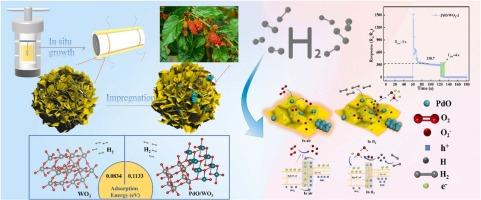IF 8
1区 化学
Q1 CHEMISTRY, ANALYTICAL
引用次数: 0
摘要
随着氢气作为清洁能源的广泛应用,其易燃易爆的危害性也逐渐受到重视。因此,开发一种响应速度快、检测速度快、检测限低的氢气传感器迫在眉睫。本文采用原位水热法和自组装浸渍法合成了一种具有果叶状结构的 PdO/WO3 复合材料,并对其氢气传感性能进行了研究。结果表明,PdO 的自组装负载可以大大提高 WO3 的 H2 传感性能,其中 PdO/WO3-1 传感器在 120°C 温度下对 100 ppm H2 的响应值非常高(338.7),响应/恢复时间非常短(1 s/4 s)。传感器性能的提高主要得益于贵金属 PdO 对 H2 的催化作用以及 WO3 和 PdO 之间的协同效应。通过改变 PdCl2 溶液的浓度,还解释了 PdO 纳米颗粒的生长节奏以及对 PdO/WO3 复合材料 H2 传感性能的影响。密度泛函理论计算证明,PdO 与 WO3 复合后,氢气传感性能得到改善。这项研究为开发基于 WO3 的高性能氢传感器提供了可行的解决方案。本文章由计算机程序翻译,如有差异,请以英文原文为准。

Ultrafast response and recovery in advanced H2 sensing: Self-assembled fruit-leaf-like PdO/WO3 nanostructures
As hydrogen is widely used as a clean energy source, the hazards of its flammable and explosive properties are gradually emphasized. Therefore, it is imminent to develop a hydrogen sensor with high response, fast detection speed and low detection limit. In this paper, a PdO/WO3 composite with fruit-leaf-like structure was synthesized by in-situ hydrothermal and self-assembly impregnation method, and its H2 sensing performance was investigated. The results show that the self-assembled loading of PdO can greatly improve the H2 sensing performance of WO3, in which the PdO/WO3-1 sensor exhibits a very high response value (338.7) and a very short response/recovery time (1 s/4 s) at 120°C to 100 ppm H2. The enhanced sensor performance is mainly due to the catalytic effect of the noble metal PdO on H2 and the synergistic effect between WO3 and PdO. The growth rhythm of PdO nanoparticles and the effect on the H2 sensing performance of PdO/WO3 composites were also explained by varying the concentration of PdCl2 solution. The density functional theory calculation proves that the hydrogen sensing performance is improved after the combination of PdO and WO3. This study provides a feasible solution for the development of high-performance WO3-based H2 sensors.
求助全文
通过发布文献求助,成功后即可免费获取论文全文。
去求助
来源期刊

Sensors and Actuators B: Chemical
工程技术-电化学
CiteScore
14.60
自引率
11.90%
发文量
1776
审稿时长
3.2 months
期刊介绍:
Sensors & Actuators, B: Chemical is an international journal focused on the research and development of chemical transducers. It covers chemical sensors and biosensors, chemical actuators, and analytical microsystems. The journal is interdisciplinary, aiming to publish original works showcasing substantial advancements beyond the current state of the art in these fields, with practical applicability to solving meaningful analytical problems. Review articles are accepted by invitation from an Editor of the journal.
 求助内容:
求助内容: 应助结果提醒方式:
应助结果提醒方式:


